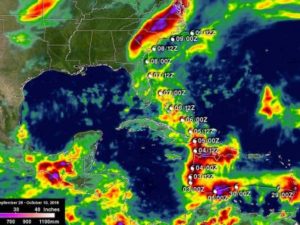Hurricane Matthew, which struck the southeastern US in early October of 2016, was no ordinary weather disaster. Although this storm will probably not go down in history competing with the infamous reputations and death tolls of Katrina or Sandy, its destruction and aftereffects have still not completely abated — several weeks after the storm passed! Matthew may well become infamous in its own right as the storm with the longest-lasting flooding, and over a vast area.
Most people who do not live in the Carolinas have little idea that the destruction is still impacting that zone. They may have read about the storm in the papers, may have seen the incredible rescue videos on TV, but now they assume that the situation has come under control. This is very far from the truth! A full two weeks after Hurricane Matthew passed through, there were some areas that were still experiencing the type of severe flooding that one would expect during the storm, not many days later.
This image shows the amount of rainfall dropped by Hurricane Matthew over the life and track of the storm. IMERG real time data covering the period from Sept. 28 through Oct. 10, 2016 show rainfall from Hurricane Matthew before and after its interaction with a frontal boundary. Matthew caused extreme rainfall in North Carolina resulting in over 20 inches (508 mm) of rain. Credits: NASA/JAXA, Hal Pierce
Here is how this storm came to tear through the Carolinas:
Hurricane Matthew formed off the coast of Africa in late September. It started as a routine tropical storm, but organized itself into a tight knot and gathered strength over the Atlantic until it had intensified into a furious Cat 5 monster of a hurricane, with winds estimated at an incredible 160 mph. Luckily, the storm weakened a bit before slamming into Haiti, where it nevertheless caused hundreds of deaths and a massive humanitarian crisis that will take many years for recovery.
After raking across Haiti, the storm plowed through the northern half of Florida, across Georgia, and then set upon the Carolinas. It is here where many factors collided to produce conditions of hellish and lingering devastation. Firstly, the unimaginable volume of water was mind-boggling: some areas recorded more than a foot of precipitation, which was added to an extremely dangerous storm surge that joined forces with a naturally-occurring high tide — all of which produced a veritable nightmare along the coasts. Fortunately, authorities were able to provide timely warnings of Matthew's approach, and mandatory evacuation orders saved an untold number of lives. The recommended evacuation zone in South Carolina was for all residents living within a full 100-miles from the coast! In spite of preemptive measures, mandatory evacuations, and early declarations of emergency, 46 people still lost their lives in the US.
After Hurricane Matthew had finished its slow path across the Carolinas, it skirted through part of Virginia and then headed back into the Atlantic. However, the aftereffects of the storm continued to plague storm victims through mid-October and beyond. Millions of residents were left without power, many people who needed emergency services died when help could not arrive, rescues numbered in the thousands, livestock drowned, and countless buildings were swept away. The incredible amount of precipitation from the hurricane storm was augmented by other, lesser storms that moved into the area directly after the hurricane, at a time when the sodden ground was incapable of further absorption. Dams and sea walls that had failed or collapsed during the hurricane released more and more water into the ravaged region. The main interstate highway, I-95, which connects and serves the entire East Coast, was closed with detours of over 100 miles in some areas! In what will clearly illustrate the scope of this disaster, authorities expected that some stretches of this vital highway would remain closed for weeks.
Hurricane Matthew, as devastating as it was, might have been worse in the US if it had struck at its full intensity. Even so, the flooding and water damage will likely cost in the neighborhood of $5.2 billion, and will earn it a place among the worst of the worst.
Source:: http://www.floodbarrierusa.com/








